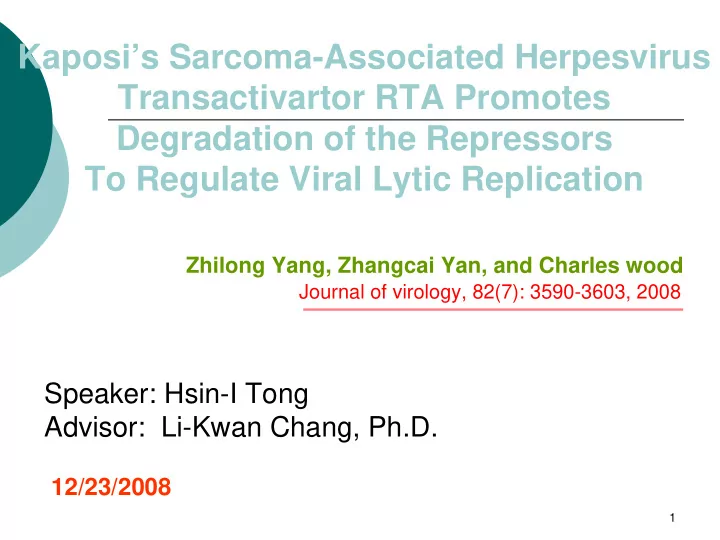

Kaposi’s Sarcoma-Associated Herpesvirus Transactivartor RTA Promotes Degradation of the Repressors To Regulate Viral Lytic Replication Zhilong Yang, Zhangcai Yan, and Charles wood Journal of virology, 82(7): 3590-3603, 2008 Speaker: Hsin-I Tong Advisor: Li-Kwan Chang, Ph.D. 12/23/2008 1
Kaposi’s Sarcoma ‧ Tumor, caused by HHV-8/KSHV ‧ One of AIDS defining illness ‧ assoicated with high mortality 2
Kaposi’s Sarcoma-Associated HerpesVirus (KSHV) ‧ Human Herpes Virus 8 (HHV-8), γ herpesvirus ‧ DNA Virus, linear dsDNA, with envelop ‧ infect B cell, endothelial cell, monocyte, nerve cells ‧ cause of Kaposi’s Sarcoma, primary effusion lymphoma,multicentric castleman’s disease (rare) 3
latent/lytic switch Immediate-early Transactivator The establishment of RTA Early latency Replication machinerises, kinase Reactivation from latency Late � lytic replication Glycoprotein, capsid protein 4
regulation of transcription activation RTA Early proteins pEarly gene pEarly gene Viral genome Viral reactivation, enter of the lytic replication ‧ KSHV Immediate early protein (ORF 50) ‧ Necessary and sufficient for virus reactivation ‧ Strong/only transcription activator ‧ Ubiquitine E3 ligase function 5
Viral/Cellular factors: K-RBP, KbZIP, NF- κ B , LANA RTA Repressor pEarly gene pEarly gene Viral genome Virus stays in latency ? RTA Early proteins Repressor pEarly gene pEarly gene Viral genome Viral reactivation, enter of the lytic replication 6
KSHV RTA binding protein (K-RBP) RTA K-RBP pEarly gene pORF57 Viral genome Virus stays in latency ‧ Cellular RTA binding protein ‧ transcriptional repressor 7
8 ‧ How RTA overcome K-RBP repression? Proposed model Objectives
Framework Proposed Model • RTA expression promotes K-RBP degradation • K-RBP degradation is mediated by the ubiquitin- proteasome pathway • Correlation of RTA-mediated transactivation and degradation 9
RTA expression promotes K-RBP degradation 10 Western blot analysis cotransfected control
KRBP turnover rate Protein synthesis inhibitor RTA enhances CHX=Cycloheximide 11
Framework Proposed Model • RTA expression promotes K-RBP degradation • K-RBP degradation is mediated by the ubiquitin- proteasome pathway • Correlation of RTA-mediated transactivation and degradation 12
13 2.Proteasome-dependent pathway 1.Lysosome-dependent pathway Protein degradation pathways ?
? RTA Early proteins K-RBP pEarly gene pORF57 Viral genome Viral reactivation, enter of the lytic replication RTA reduce K-RBP protein level ? RTA K-RBP pEarly gene pORF57 Viral genome Fail entering viral reactivation RTA do not reduce K-RBP protein level 14
Proteasome-dependent inhibitor Lysosome-dependent inhibitor RTA promotes K-RBP degradation via the proteasome-dependent pathway 15
Ubiquitination Ubiquitin-conjugating enzyme Ubiquitin-activating enzyme Proteasome-dependent degradation Ubiquitin-protein ligase 16
Immunoprecipitation (IP) Anti-KRBP protein-protein binding His Anti-His HA HA K-RBP Anti-HA Ub HA Ub HA Ub Ub In Vivo ubiqutination of K-RBP (withou RTA) 17
K-RBP Ubiquitination increased in the presence of RTA In Vitro In Vivo 1 2 3 4 1 2 3 4 Human E2 RTA(E3) enhance ubiquitination of K-RBP 18
Framework Proposed Model • RTA expression promotes K-RBP degradation • K-RBP degradation is mediated by the ubiquitin- proteasome pathway • Correlation of RTA-mediated transactivation and degradation 19
Framework K-RBP repress RTA-mediated transactivation b U b RTA U Ub b U K-RBP pEarly gene pORF57 Enter lytic replication Fail entering viral reactivation Viral genome • Correlation of RTA-mediated transactivation and degradation 20
21 Detection luciferase luciferase luciferase Luciferase Luciferase assay pORF57 RTA
22 Luciferase activity represent RTA transactivation activity
For the White bar RTA RTA Transactivity Luciferase gene pEarly gene pORF57 set as 100% Viral genome 23
Luciferase activity represent RTA transactivation activity Set as 100% in each concentration 24
RTA transactivity b partically blocked U b RTA U Ub by K-RBP b U K-RBP RTA Transactivity Luciferase gene pEarly gene pORF57 Viral genome 25
Luciferase activity represent RTA transactivation activity % inhibited by K-RBP Set as 100% in each 74% concentration 17% 26
RTA wild type vs. RTA mutant (lower degradation ability) Lower degradation ability associates with lower transactivation ability 27
28 Summary
Special Thanks Dr. Li-Kwan Chang Thank you Thank you 29
Recommend
More recommend